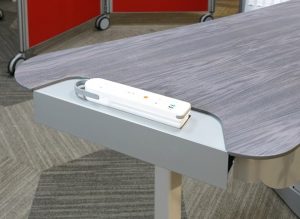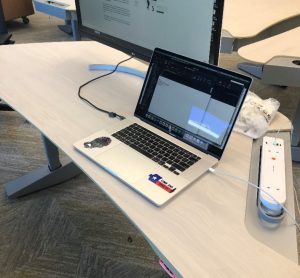In the past, sustainability in furniture manufacturing typically involved using sustainable materials and sustainable processes.
Now, battery power adds another facet to our sustainability story.
The next steps for powering offices and office equipment are both practical and meaningful for the way businesses impact the electrical grid. Respond! is an investment that meets the technical requirements for a future that is not very distant.
Let us consider two scenarios.
Scenario #1: Conventional Wisdom
In the first scenario, a parcel of land somewhere in a sunny climate, for example a California desert, is covered with solar panels. The panels, obviously the most efficient in the midday sun, generate DC current.

This current goes through an inverter that turns DC power into the more familiar-to-most-people AC current. To send the current to its users, say a metropolitan area in California, the AC current next goes through a “step-up” transformer to create higher voltages so it can be efficiently transported over long distances on handsome steel towers (scorn intended). Some people in California, which has suffered several conflagrations due to failing transmission systems, have proposed to rebuild the entire grid. Even California would be challenged to pay for this.
When the power arrives at its intended neighborhood, it goes through a “step-down” transformer at a substation that lowers the voltage for local distribution. Local distribution is that part of the grid that you see on wooden poles. Next, near to your house or office it goes through another “step-down” transformer that converts it to the 120V power that you have used for decades.
When you plug in your laptop computer, there is another device, a power supply (sometimes referred to as the “brick”) that converts the 120V AC power to a lower voltage DC power that your computer uses.
A century ago, this was considered an efficient design. Generate power in a distant location. Then transport it on steel towers across the landscape to its place of use.
Never mind that there is a loss of energy (in the form of heat) at every step in the process. Every transformer, inverter, and power supply involved in the system is less than 100% efficient. If there are any transformers and power supplies inside your building, you might pay twice for the energy loss. Once at the device, and a second time when your air conditioner removes the heat.
It can be argued that solar or wind generation is better for the environment than other forms of generation, but these are solutions for only part of the problem. You still have the issue of matching peak demand to peak generation as peak demand often correlates with air conditioning loads. These demands extend into the later parts of daylight hours, not exactly at the time when there is peak generation.
Another issue is managing the grid itself. Generation of power on one part of the grid does not ensure there is enough transmission capacity to deliver the power where there is demand.
Let us examine another choice.
Scenario #2: A Better Choice
In this scenario, you add solar panels or wind turbines on the roof, over the parking lot, or on the sides of your building.
DC power is generated and fed directly into a local DC microgrid that serves your facility. There are no inverters, no transformers, no power supplies that are required, and thus little energy is lost due to the inefficiencies of the system.

If there is sufficient space for solar or wind generation, it is possible to “island” your facility. Some refer to this as a micro-utility. If there is insufficient space, a hybrid AC/DC solution can be implemented where power comes from both sources.
The DC microgrid or hybrid AC/DC microgrid can directly and efficiently power the devices you use or charge batteries for use later in the day when sunlight fades. If there is not enough power generated during daylight hours, you can charge your batteries during the night using off-peak, lower-cost power.
Another part of the solution is to add more battery storage. Additional system-wide on-premises battery storage can serve as a power reservoir for short-term storage or to deal with weather variations.
Where does the August Berres Power System fit in this scenario?
Since 2019 all laptops have been manufactured with USB-C connections. USB-C can provide DC current plus data plus video all through the same desktop wiring. Other office equipment including monitors and printers now conform to USB-C connection systems.
Businesses that invest in solar and battery storage reduce the stress on the grid when there is peak demand. In California, the 2022 Energy Building Codes are published, and they require both solar generation and battery storage for almost every new residential and commercial building.
For many businesses, the rates paid for electricity each month are calculated from the peak demand in the previous month. For these businesses, anything that reduces peak demand reduces cost. The power generated on-site is “behind the meter” and not subject to charges billed by utilities for transport on the grid.
Localized generation and battery storage is not simply good for business, it is good for public policy. Grid replacement costs can be reduced if peak demand is reduced. We could also live with fewer Peaker plants, high cost generating sources part of today’s grid design that are only required to meet peak demand.
To learn more about this new technology, visit AugustBerres.com


